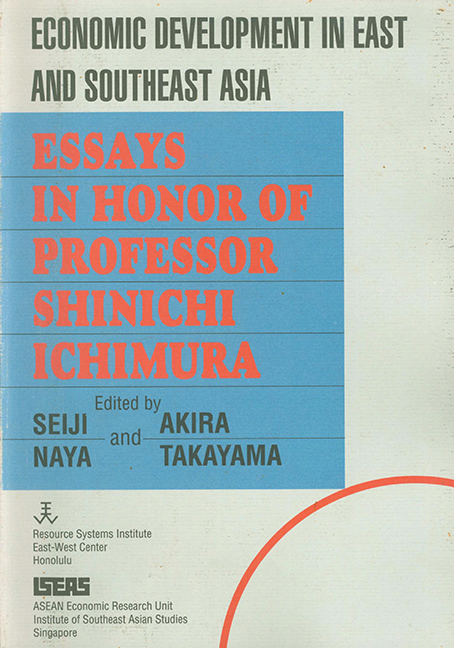Book contents
- Frontmatter
- Preface
- Shinichi Ichimura, 1925-
- CONTENTS
- Introduction
- Contributors to This Volume
- I Structural Change and Economic Development in Developing Asia in the 1990s
- II Explaining the Success of the Four Little Dragons: A Survey
- III Taiwan's Economic Miracle: A Singaporean Perspective
- IV Singapore's Experience of Industrial Restructuring: Lessons for the Other Asian NIEs
- V Korean Industrial Policies for Declining Industries
- VI Vietnam: Recent Economic Developments and the World Economy
- VII Transition from Import Substitution to Export Expansion: The Thai Experience
- VIII Adjustment Problems of a Small Oil-Exporting Country: Did Indonesia Suffer from the Dutch Disease?
- IX A Quarterly Econometric Model of the Hong Kong Economy
- X The Effect ofRicardian Rent Extracting on Macroeconomic Performance
- XI Direct Foreign Investment and the Economic Development of Korea
- XII Japanese Investment in Thailand: Looking Back and Into the Future
- XIII The Effects of Direct Foreign Investment on Taiwan: A Macroeconometric Investigation
- XIV A Reform of the Foward Foreign Exchange Market and Foreign Exchange Rate Determination Policy in Korea, with Foreign Exchange Policy Experiences of Taiwan
- XV Interest Rate and Foreign Exchange Liberalization in Taiwan in the 1980
- XVI Manifold Dilemmas behind External Debt Management
- XVII Agricultural Growth and Food Imports in Developing Countries: A Reexamination
- XVIII The Transformation of Rural Asia and Economic Development Theory and Policy
- XIX The ASEAN Summit and ASEAN Economic Cooperation
- XX The Role of Developing Countries in the New GATT Round
- XXI The Emerging Global Economy and the Role of the Asian NIEs
- Index
XII - Japanese Investment in Thailand: Looking Back and Into the Future
Published online by Cambridge University Press: 21 October 2015
- Frontmatter
- Preface
- Shinichi Ichimura, 1925-
- CONTENTS
- Introduction
- Contributors to This Volume
- I Structural Change and Economic Development in Developing Asia in the 1990s
- II Explaining the Success of the Four Little Dragons: A Survey
- III Taiwan's Economic Miracle: A Singaporean Perspective
- IV Singapore's Experience of Industrial Restructuring: Lessons for the Other Asian NIEs
- V Korean Industrial Policies for Declining Industries
- VI Vietnam: Recent Economic Developments and the World Economy
- VII Transition from Import Substitution to Export Expansion: The Thai Experience
- VIII Adjustment Problems of a Small Oil-Exporting Country: Did Indonesia Suffer from the Dutch Disease?
- IX A Quarterly Econometric Model of the Hong Kong Economy
- X The Effect ofRicardian Rent Extracting on Macroeconomic Performance
- XI Direct Foreign Investment and the Economic Development of Korea
- XII Japanese Investment in Thailand: Looking Back and Into the Future
- XIII The Effects of Direct Foreign Investment on Taiwan: A Macroeconometric Investigation
- XIV A Reform of the Foward Foreign Exchange Market and Foreign Exchange Rate Determination Policy in Korea, with Foreign Exchange Policy Experiences of Taiwan
- XV Interest Rate and Foreign Exchange Liberalization in Taiwan in the 1980
- XVI Manifold Dilemmas behind External Debt Management
- XVII Agricultural Growth and Food Imports in Developing Countries: A Reexamination
- XVIII The Transformation of Rural Asia and Economic Development Theory and Policy
- XIX The ASEAN Summit and ASEAN Economic Cooperation
- XX The Role of Developing Countries in the New GATT Round
- XXI The Emerging Global Economy and the Role of the Asian NIEs
- Index
Summary
“If all the Japanese cars in Thailand were taken away, then all the roads in the country would be empty. If all the Japanese radios, televisions and electronic and electric appliances suddenly disappeared from the Thai households, then all the households would be as silent as graves. If clothing with Japanese trademarks were taken away from the Thai people, then all the Thais would be naked. How completely are the Thais under Japanese influence” (Phatsaong and Chingchit 1972, p. 13).
The above extract is taken from a well-known article written by two student activists published in the Social Science Review. It sparked off an anti-Japanese movement in Thailand in the early 1970s and reflected the perceived position of Japanese firms in trading and manufacturing activities, especially in the production of consumer goods. At that time, the cumulative investment from Japan in the manufacturing sector promoted by the Thai government between 1960 and 1974 accounted for 29 percent of the total registered foreign capital which made Japan the largest investor. However, flow data recorded by the Bank of Thailand for the same period shows Japan to have been the second largest investor after the United States. It is believed that Japanese investment was under attack at that time, not because of its pervasiveness or its scale in the economy, but because Japanese-related activities were in the more conspicuous activities.
As the anti-Japanese movement, along with the student movement, subsided with the change in the government, Japanese investments in Thailand continued to increase. As Japan emerged as the wealthiest country and the economic hegemon of the free world, her global overseas investments, including those in Thailand, expanded further. And in 1987, Japan's registered capital in the promoted sector exceeded the total cumulative investments made during the past two and a half decades.
This paper traces the development of Japanese investment in Thailand and attempts to answer the following questions: When did Japan become the largest investor in Thailand? What has been the pattern of Japanese investment and the mode of operation? What are the contributions of Japanese investments as assessed by Thai scholars? And what, are the new trends in Japanese investment in Thailand?
In the next section, a brief discussion of the performance of the Thai economy is given.
- Type
- Chapter
- Information
- Economic Development in East and Southeast AsiaEssays in Honor of Professor Shinichi Ichimura, pp. 185 - 201Publisher: ISEAS–Yusof Ishak InstitutePrint publication year: 1990



